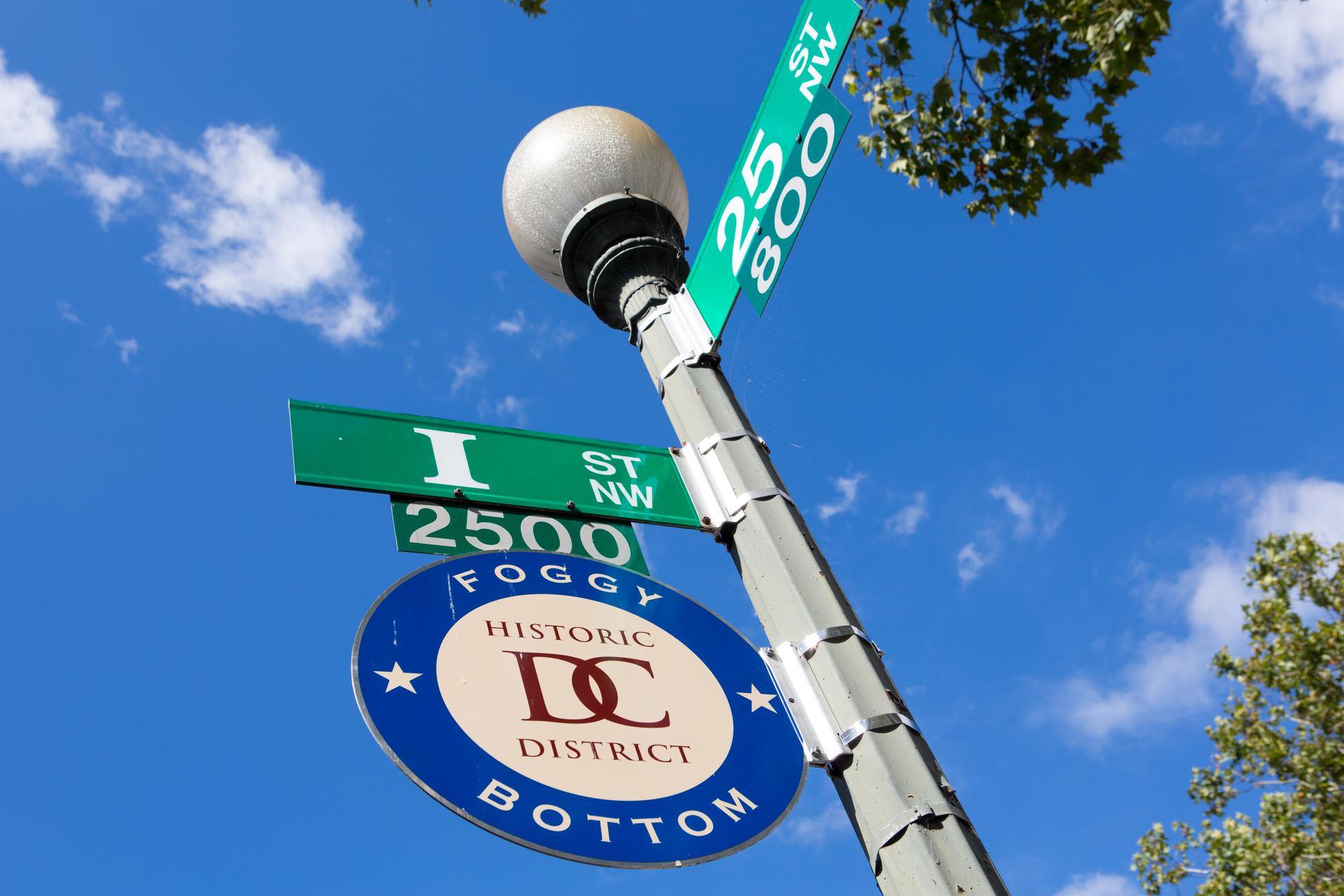Washington, D.C., is more than the seat of the national government. The DMV—the District of Columbia, Maryland and Virginia—is home to broad, diverse communities whose offerings include food and drink, art, history, performances, parks, waterfronts and more, much of it a quick bus or Metro ride away.
Whether you’re a new Revolutionary or a returning one, there’s always more to explore in the city the George Washington University calls home. Foggy Bottom, where the university has been rooted since the early 20th century, lies north of the National Mall and stretches from the White House at its eastern limit to Georgetown at its west. Here’s a short guide to some of the neighborhood’s history and highlights.
History
Foggy Bottom draws its evocative name from the mist rolling off the Potomac River and perhaps also from the industrial smog that once hung over its streets. As D.C.’s 19th-century manufacturing hub, the neighborhood was home to breweries, glass factories and the Washington Gas and Light Company and, more importantly, to the predominantly immigrant and minority population that worked there. After slavery was abolished in Washington, D.C., in 1850, an increasing number of Black families moved to the neighborhood for work, and the community has remained present and vibrant through the turbulent decades that followed.
The George Washington University moved to 2023 G St. NW in 1912 and soon established itself as a local presence. But around GW, the neighborhood was changing. A weak national economy and the austerity of Prohibition took their toll on area industries in the 1920s, and by the 1940s only the poorest residents remained, many of them Black. The neighborhood was institutionally neglected and chronically underserved. According to a 1944 Washington Housing Association survey cited by WAMU, over half of the population shared or had no bathing and toilet facilities, a quarter had no running water and a fifth had no electricity.
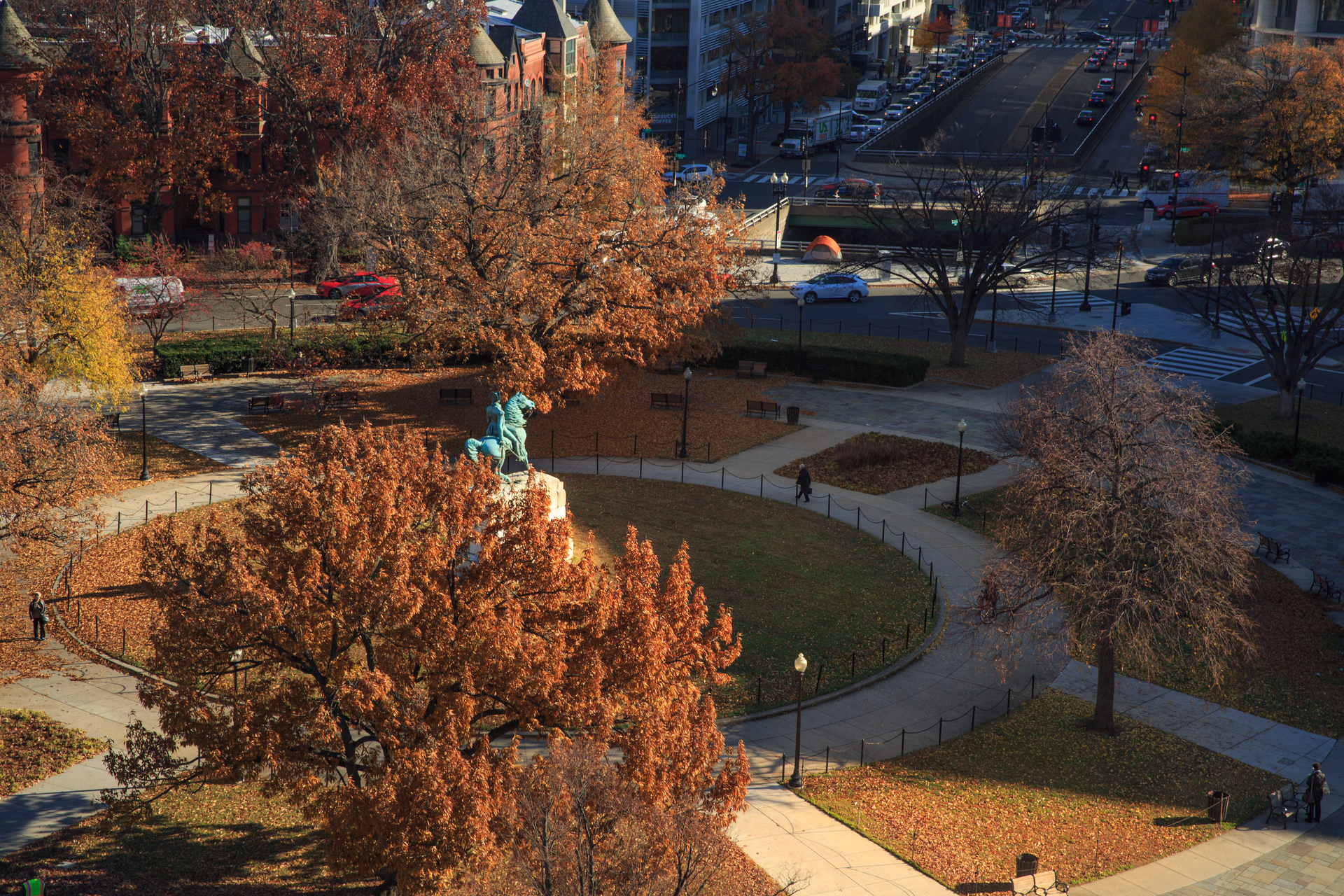
Washington Circle, where the George Washington University Hospital now stands, was once known as “Round Tops” after the notorious Irish gang that controlled it. (William Atkins/GW Today)
That poverty made the neighborhood vulnerable to redevelopment, beginning when the Department of State moved its headquarters to Foggy Bottom in 1949. The neighborhood now serves as a center for several major national and international organizations, including the World Bank and International Monetary Fund. It’s also home base for many GW students, with a lot to explore between classes.
Where to Eat
Foggy Bottom offers copious meal options. GWorld cardholders can use their Dining Dollars (for residential students) or Campus Cash (for faculty, staff and non-residential students) at many dining and grocery partners on and near campus. One favorite is GW Deli (2133 G St. NW), a student institution for decades, which offers sandwiches that are worth the sometimes-intimidating lines.
Students line up to get caffeinated at the nearby Starbucks (2130 H St. NW), but there are plenty of tasty alternative options, like upscale bakery and sandwich spot For Five Coffee Roasters (2001 Pennsylvania Ave. NW) or the Farragut Square outposts of Compass Coffee (849 18th St. NW), locally brewed and roasted in D.C., and La Colombe (1710 I St. NW). Lunch mainstay Poppabox (1928 I St. NW) has a variety of quick, affordable options for those who like eating to-go, as does Jetties (1921 I St. NW), which won student journalists’ approval in the “best on-the-go lunch” category last year. Sweetgreen (2221 I St. NW) offers quick, tasty pickup near the Science and Engineering Hall.

Diners at a food truck at Potomac Square. (William Atkins/GW Today)
The pedestrian mall at 2000 Pennsylvania Ave. NW was revamped in 2021 as Western Market, hosting a variety of old and new favorites including Bullfrog Bagels, D.C. family-owned Roaming Rooster and Falafel Inc. For happy hour or a sit-down meal, try gastropub options at Duke’s Grocery, a hot slice at Andy’s Pizza, sushi and sake at Onkei or savory Indian street food at Bindaas. Grab dessert, including local creamery ice cream, at longtime favorite Captain Cookie and the Milkman.

Andy's is one of the latest additions to Western Market. (William Atkins/GW Today)
Across the street from Western Market is Founding Farmers (1924 Pennsylvania Ave.), co-owned by GW alum and part-time faculty member Dan Simons, B.B.A. '92, which prioritizes tasty farm-sourced ingredients and sustainable practices. Locals also recommend the tater tots at Tonic (2036 G St. NW), where the walls are lined with photos of Foggy Bottom through the last century. Casta’s Rum Bar (1121 New Hampshire Ave. NW) boasts an impressive tropical drink selection.
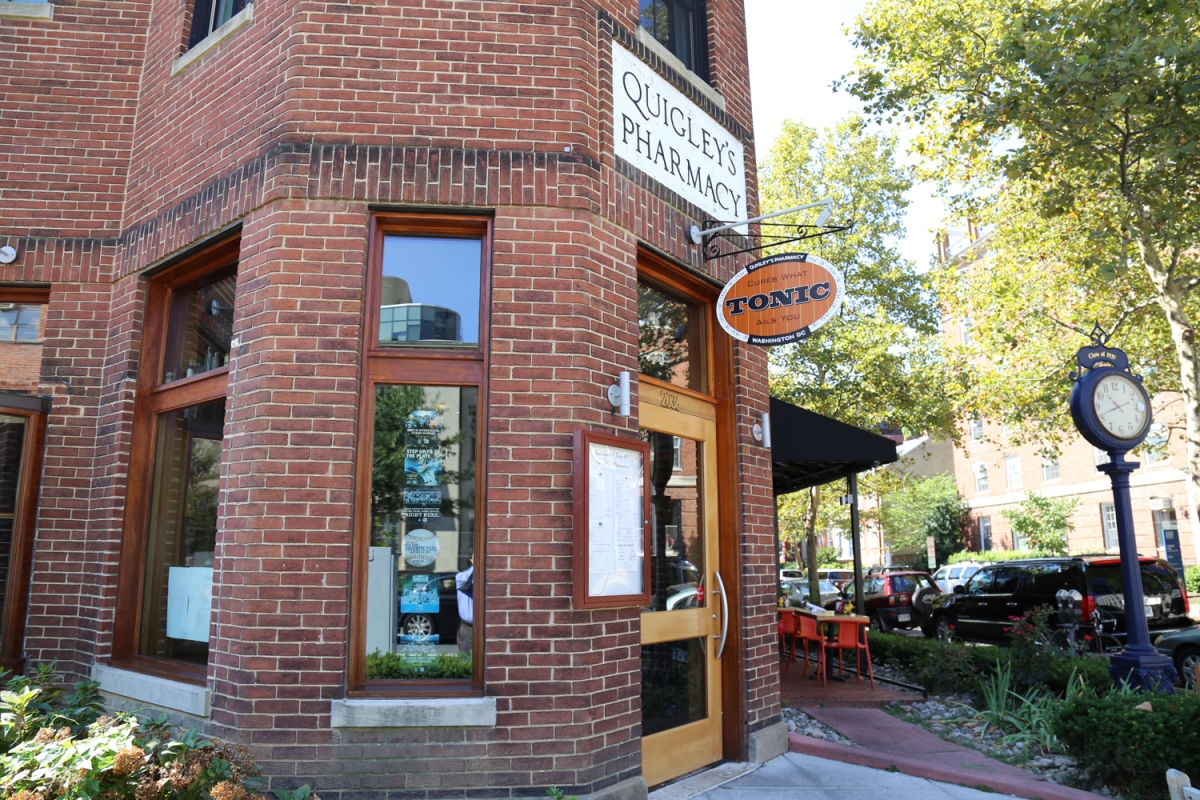
Tonic has been a favorite Foggy Bottom happy hour spot for decades and was a local pharmacy before its conversion. (Robert Stewart/GW Today)
Local special-occasion favorites include KAZ Sushi Bistro (1915 I St. NW), Rasika West End (1190 New Hampshire Ave. NW) and the Michelin-starred Blue Duck Tavern (1201 24th St. NW).
Residence hall District House (2121 H St. NW) is open only to GWorld cardholders, to whom it offers a full dining experience with new vendors and kiosk ordering.
Home cooks can pick up groceries at Whole Foods (2201 I St. NW) or Trader Joe’s (1101 25th St. NW), plus seasonal produce and local artisan goods at the FRESHFARM Farmer's Market (23rd and I streets NW) on Wednesday afternoons almost year-round.
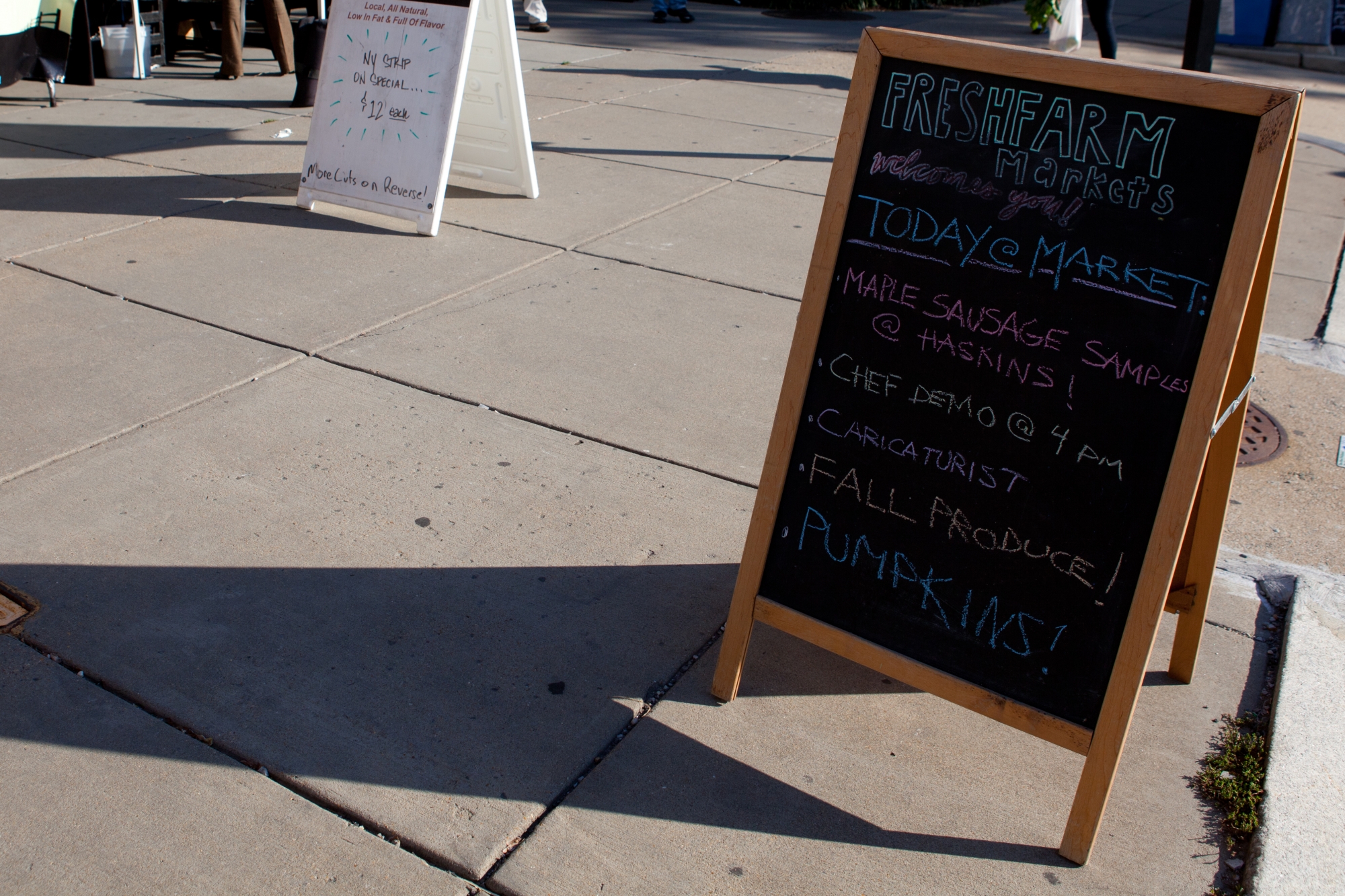
The FRESHFARM Farmer's Market opens at 3 p.m. Wednesdays. (Jessica McConnell Burt/GW Today)
What to Do
Visit museums and historic sites
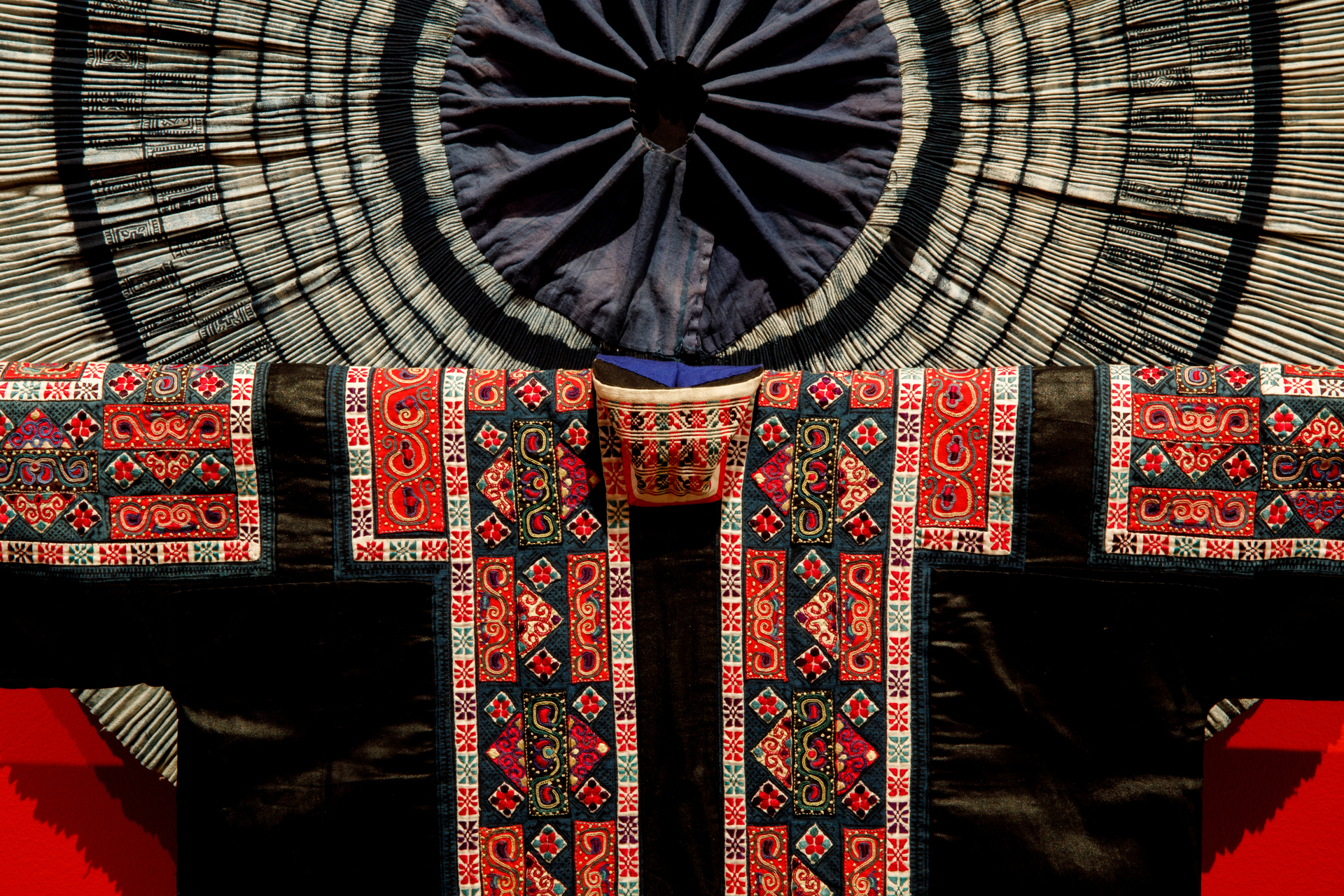
Pieces from an exhibition at the George Washington University Museum and The Textile Museum. (William Atkins/GW Today)
The George Washington University Museum and The Textile Museum combines two Foggy Bottom institutions: The Textile Museum’s vibrant collection of textile art spanning five continents and five millennia, and the Albert H. Small Washingtoniana Collection of historic artifacts telling the story of the nation’s capital. Besides selections from the permanent collection, the museum also features rotating exhibitions on topics from historic costume to contemporary art. Right now, check out both centuries' worth of global textile beauty at the museum's centennial exhibition, "Enduring Traditions: Celebrating the World of Textiles," and ecologically responsible innovations in material and design at “Source Material: Lessons in Sustainable Fashion.”
The Corcoran School of the Arts and Design’s historic Flagg Building is home to a series of rotating fine-art exhibitions, including those belonging to the Luther W. Brady Art Gallery.
Just across from the White House, the Renwick Gallery (Pennsylvania Ave. at 17th St. NW) showcases the Smithsonian Institution’s collection of craft and decorative art, and as with all Smithsonian museums, admission is free. The Renwick is one of the Smithsonian’s lesser-known outposts, but insiders love its focus on understudied artists and art forms.
The Foggy Bottom Historic District includes the district’s oldest structure: a frame dwelling at the corner of 25th and Eye streets said to have been associated with the Underground Railroad. (The structure now comprises 822, 824, 826 and 828 25th St. NW.) For those who like to wander, the Foggy Bottom Association has created multiple self-guided walking tours of historic Foggy Bottom featuring sites of artistic, historical and social significance.

More row houses in the Foggy Bottom historic district. (Jessica McConnell Burt/GW Today)
Political history junkies can visit the Watergate Hotel (2650 Virginia Ave. NW), and even book Room 214, used in the original break-in that made the hotel a household name. If you’re intrigued but not down for that kind of commitment, you can still have a drink with some history behind it at the hotel’s rooftop bar, Top of the Gate. Or saunter over to Off the Record (800 16th St. NW), the cozy, semi-hidden bar at the Hay-Adams Hotel that has hosted its share of cloak-and-dagger doings.
At the far south of the neighborhood, on the grounds of the National Academy of Sciences, stands the Albert Einstein Memorial (2101 Constitution Ave. NW), a 21-foot bronze statue erected in 1979 to commemorate the 100th birthday of this scientific and humanist icon—an inspiring place to read or study on a sunny day.
Find nature in the city

A view of the Watergate complex from Rock Creek Park. (Wikimedia Commons)
Joggers, cyclists, aspiring birdwatchers and anyone who needs a break from city bustle will relish the nearby tree-shaded paths of Rock Creek Park. (If you prefer wheels to walking, nearby bikeshares offer rentals to riders who don’t have their own.) Even the least picturesque entrances to the park contain hidden treasures: Near an intimidating highway onramp at 2701 K St. NW are the Godey Lime Kilns, where limestone ferried down the C&O Canal was once broken down into plaster and lime for local construction. Now ruined, the kilns are a window into the area’s industrial past.
If you’re interested in the life aquatic, you can rent a boat at Thompson Boat Center (2900 Virginia Ave. NW) between April and October. Not ready to handle your own craft yet? The center offers kayaking, paddleboarding and other maritime classes.
Root, root, root for the home team

Basketball season kicks off in November. (GW Athletics)
Cheer on GW’s basketball, volleyball and gymnastics teams at the Charles E. Smith Center. (Soccer, lacrosse, tennis and softball take place in the Foxhall neighborhood on the Mount Vernon Athletic Fields.)
Take in a performance
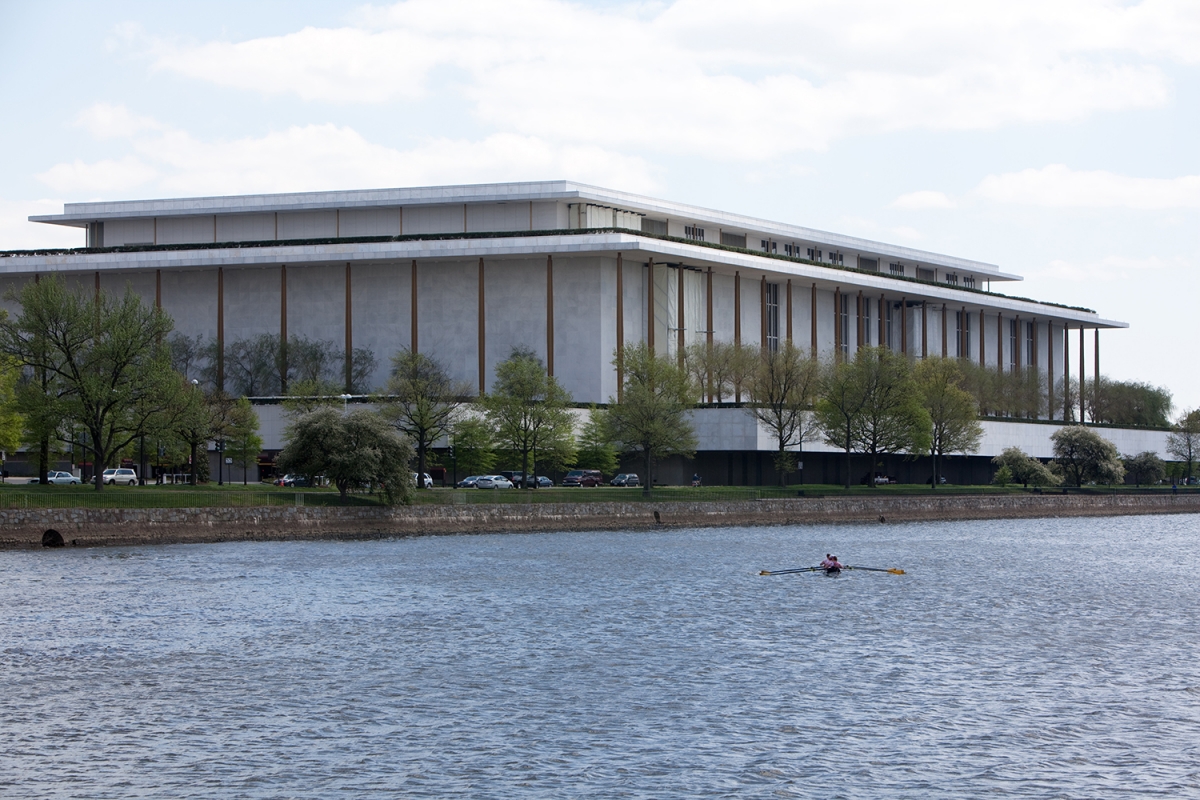
The Kennedy Center doesn't just offer plays and concerts. Visitors also can ascend to the terrace to take in a different kind of show: the panoramic view across the Potomac. (William Atkins/GW Today)
Keep an eye on the University Calendar to find out when GW students and groups mount performances on campus or when Lisner Auditorium hosts visiting artists. And you can always catch the complimentary shuttle from the Foggy Bottom Metro to the Kennedy Center, where options range from splurge-worthy tickets like “The Sound of Music” to free daily shows at Millennium Stage and special workshops at its arts campus, The REACH.
Indulge in Revolutionary retail therapy

The GW Campus Store offers a variety of goods for proud Revolutionaries. (William Atkins/GW Today)
Dedicated shoppers will head straight to Georgetown, but they should stop first at GW’s state-of-the-art campus store, unveiled last year at 2100 Pennsylvania Ave. NW, which features not just Revolutionary gifts and gear but also electronics, books and items from local D.C. makers.


